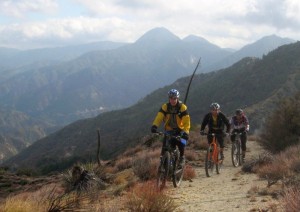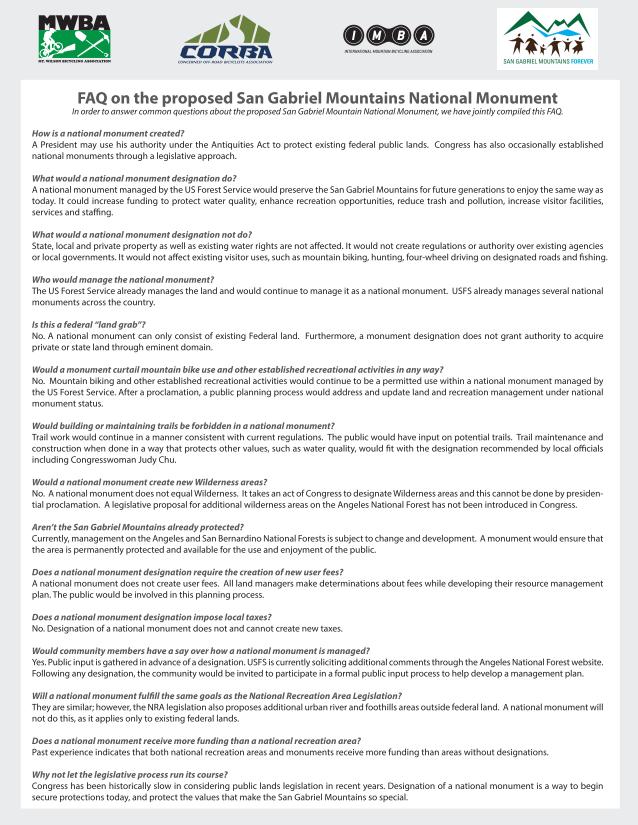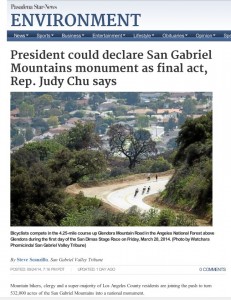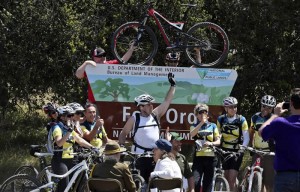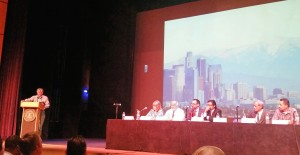 Last night an overflowing crowd packed into the Baldwin Park Performing Arts Center to hear from a panel of “experts” about the future of the San Gabriel Mountains. Among the honored guests and panel of experts were Robert Bonnie, the undersecretary for the Department of Agriculture, Tom Tidwell, Chief Forester of the Forest Service, Randy Moore, Regional Forester for the Southwest United States, and congressmen Judy Chu, Los Angeles County Supervisor-elect Hilda Solis, Janice Rutherford, San Bernardino Board of Supervisors Chairperson. Local politicians and wilderness advocates rounded out the panel, with Victor Diaz, chair of the Friends of the Angeles group, as the sole “user group” representative.
Last night an overflowing crowd packed into the Baldwin Park Performing Arts Center to hear from a panel of “experts” about the future of the San Gabriel Mountains. Among the honored guests and panel of experts were Robert Bonnie, the undersecretary for the Department of Agriculture, Tom Tidwell, Chief Forester of the Forest Service, Randy Moore, Regional Forester for the Southwest United States, and congressmen Judy Chu, Los Angeles County Supervisor-elect Hilda Solis, Janice Rutherford, San Bernardino Board of Supervisors Chairperson. Local politicians and wilderness advocates rounded out the panel, with Victor Diaz, chair of the Friends of the Angeles group, as the sole “user group” representative.
Also in the room were Tom Contreras, Supervisor of the Angeles National Forest, as well as Jody Noiron, Supervisor of the San Bernardino National Forest, and all of their respective district rangers. In fact there were more Forest Service staff and volunteers on hand than any event or public meeting I’ve ever had the privilege to attend.
The auditorium was packed to capacity, with over 200 people unable to enter the room because room capacity has been reached. The WIlderness Society and San Gabriel Mountains Forever group were offering free buses to the meeting, helping explain the huge turnout.
We learned from Tom Tidwell that a number of improvements will be happening in 2015, including new staff hires, new signage and other improvements to the forest. Trail Crews from the Los Angeles Conservation Corps and Urban Youth League are out continuing to restore and repair trails.
The panel were each asked a single orchestrated question by Oscar Gonzales, California State Executive Director of the Farm Services Agency, who also flew out from Washington DC. Their answers were well-orchestrated, mostly singing the potential praises of a National Monument. There were no specific plans or proposals revealed. Only Janice Rutherford from San Bernardino County asked the important questions: how will this be managed, what is the management plan, how will this be funded, how will economic development (for areas such as Wrightwood), recreation and conservation be balanced and impacted. Most importantly, why is this happening so suddenly with no outreach or input to her community?
I could ask the same… why no outreach to our community (of mountain bikers)?
In fact, for all the talk of how this process is starting, there was not even an opportunity to ask questions, and oversized postcards were the only means given to submit anonymous comments. There are no resources or commenting options available online.
After the meeting, in my conversations with the wilderness advocates, and with Tom TIdwell by Jenny from Mount Wilson Bicycling Association, we were given some verbal assurances: That the Forest Service would continue to manage the proposed National Monument, and that the intent is to continue to allow all forms of recreation currently allowed. These verbal assurances, while comforting, came with a caveat of “no guarantees.”
The stature of the dignitaries in town for this theater of support that there has to have been some very high-level discussions and planning going on behind the scenes. But for this meeting, the first real public outreach, nobody was able to refer to a specific plan, the language of the proclamation, nor discuss the ulterior motives of those behind the plan.
For that we need to dig a little further into the history of the efforts to “protect” the San Gabriel Mountains. In 2003 Hilda Solis and Barbara Boxer introduced the San Gabriel Watershed Study, to determine the area’s suitability for a National Recreation Area. Separately, The Congressionally authorized Rim of the Valley Study has been taking place over a similar time span. Most recently, the four Southern California National Forests were charged with re-assessing and amending their management plan, with a greater emphasis on protecting the landscape for threatened and endangered species habitat protection. We are still waiting on the final outcome of that land management plan amendment, but as of our last meetings, the Fish Canyon area north of Castaic was being proposed as a Recommended Wilderness. Additionally, David Drier introduced a wilderness bill in 2011, and Congressman Buck McKeon is currently considering another.
The San Gabriel Mountains Forever group, with close ties to the Wilderness Society and the Sierra Club, have been lobbying hard for additional resources and protection for the San Gabriel Mountains.
Congressman Judy Chu has introduced two bills, one to create a National Recreation Area, the other to declare many thousands of acres of new Wilderness, including Condor Peak, Fish Canyon, Red Mountain and other areas. The Forest Service’ own Land Management Plan amendments determined that Condor Peak and Red Mountain were a) not suitable for wilderness protection, and b) would be provided little if any additional “protection” by a Wilderness designation. We have to ask why does Chu’s bill ask for these additional wilderness areas that have been fought over and removed from previous wilderness legislation, and found unsuitable? Our official comments on that plan reflected this. Her National Recreation Area bill was similarly vague on specifics, and we thought, premature.
Frustration with the lack of congressional support for those bills is what supposedly drove Chu to petition the White House for a National Monument declaration, which bypasses congress and the debate and scrutiny it would receive there. The President, under the Antiquities Act, can declare a National Monument without the support of Congress.
At this time we simply do not have enough information to make an informed decision as to whether the National Monument is a good idea that will help Forest visitors, or one that will just add an additional layer of bureaucracy. The way some of the panel gushed about the plan, one could be led to believe that the declaration would instantly take care of overflowing trash, lack of bathrooms and facilities, trail maintenance, graffiti and other problems. But there has been no talk of how much, if any, additional funding this would bring, now how it will be managed and implemented.
We’d like to see the San Gabriel Mountains receive a new influx of funding and staff. We’d like to see better services and infrastructure needed to protect the mountains, and continue to allow us to recreate responsibly. A National Monument may in fact be the vehicle to get us there. We simply don’t have enough detailed information to make that decision.
We plan to meet with congress members whose districts include portions of the San Gabriel Mountains, as well as the conservationists that are lobbying hard for this. Until we have some face-to-face time with these people, and have answers to our questions, we must remain officially neutral, while at the same time being guardedly optimistic for the future of our beloved mountains.
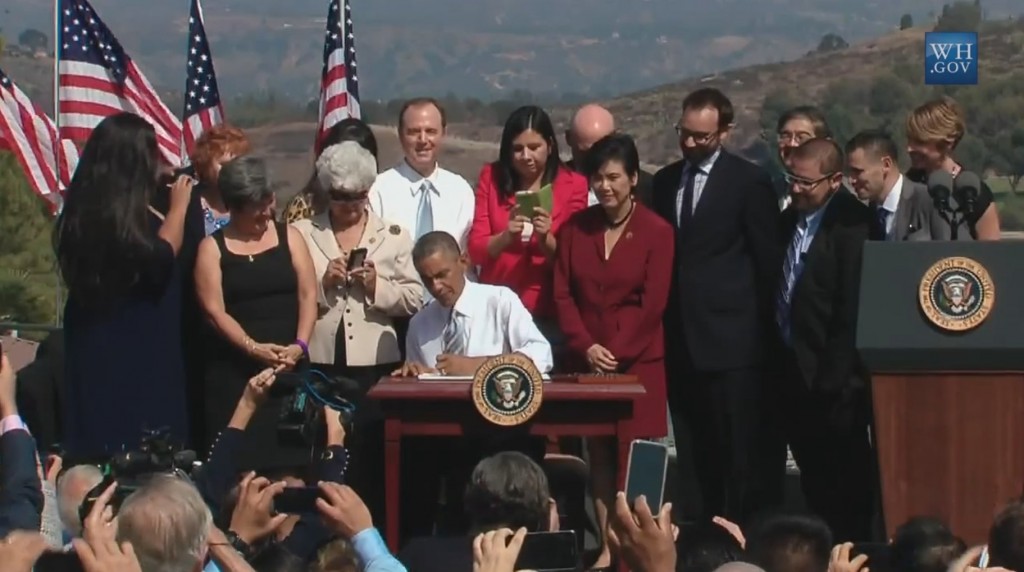


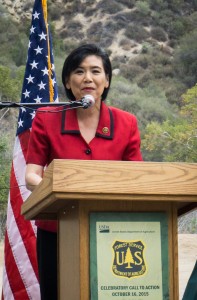
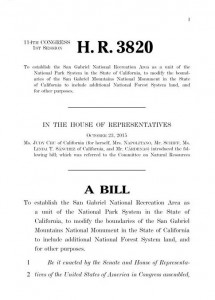
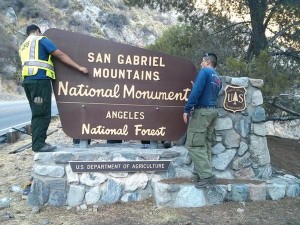 Since this was the first meeting of the full collaborative group, most of the day was spent going over and refining the draft documents that the steering committee had prepared. This included the guiding documents for the Collaborative, the Statement of Purpose, the Goals and the Code of Conduct. There was a lot of similar discussions to those the steering committee had already had, but these new points of view raised some issues that weren’t well-covered in our draft. We refined the documents and by day’s end, the group had formally ratified and adopted them.
Since this was the first meeting of the full collaborative group, most of the day was spent going over and refining the draft documents that the steering committee had prepared. This included the guiding documents for the Collaborative, the Statement of Purpose, the Goals and the Code of Conduct. There was a lot of similar discussions to those the steering committee had already had, but these new points of view raised some issues that weren’t well-covered in our draft. We refined the documents and by day’s end, the group had formally ratified and adopted them.